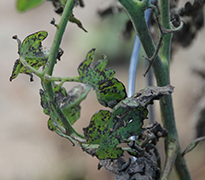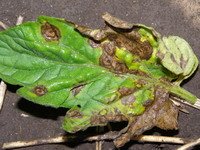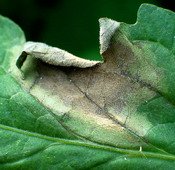Most of the questions that will be coming in will relate to tomato problems, and earlier this summer, relate to tomato problems in South Dakota. Despite early predictions that this summer was going to be dry, many areas have received above average rainfall with many parts of South Dakota far exceeding typical rainfall amounts in the month of June. Very warm and humid weather was also common in early this month which helped to spawn thunderstorms that produced high winds, heavy rain and in isolated areas, hail.
Common Wet-Weather Diseases
As in most years, the most frequent problem with tomatoes this year will be leaf spot and blight being so humid and wet. There are several common fungal blights with Septoria leaf spot being the most common. It causes small dark spots on the leaves then the leaves tend to turn yellow and fall off. It usually starts at the bottom of the plant and works its way upwards. It is favored by wet and humid weather so the rainy weather we have seen in many areas is very conducive to its development and spread. If you water your garden with overhead sprinklers, that can spread it too. This disease usually does not cause damage to the fruit, but the plant loses so many leaves that it cannot support a good crop of fruit.

Septoria Leaf Spot Fungus
The other two main diseases of tomato are late blight and early blight, but I have not seen many samples of either of these two diseases yet. They cause larger spots to develop on the leaves, stems and fruit. They are also caused by fungal pathogens. Protective fungicides containing chlorothalonil (Daconil®) can help with all these diseases but they need to be applied at the first signs of the disease to protect the young growing leaves.

Early Blight Fungus

Late Blight Fungus
Bacterial spot and bacterial speck may also be a concern. These bacterial diseases cause small dark spots to develop on the fruit and leaves. The spots are usually surrounded by a yellow halo at initial stages of the disease. Unlike the fungal diseases, fungicides are of little use in controlling bacterial disease problems. But if you can find garden disease control products that contain copper, these may be helpful in slowing the spread of these diseases.
Mulching around the plants will also help using either plastic or an organic mulch like old straw or alfalfa hay. Spacing plants apart and staking to allow for good air circulation is also helpful. Using tomato cages around plants can help too. Unfortunately, most of the inexpensive tomato cages that are sold are simply not that strong and usually collapse under the weight of a large plant bearing multiple fruits on each stem, so I pound a tee post into the ground and tie it to the cage. A stronger cage or other support is more helpful. If stems break off over the cages, this will also decrease yield. Using drip tube irrigation helps control foliage diseases by keeping them dry.
